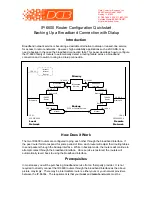
Data Comm for Business, Inc.
2949 County Road 1000 E
Dewey, IL 61840
217-897-6600, FAX 217-897-1331
Outside Illinois: 800-4DCBNET
http://www.dcbnet.com
8. Serial-B PPP Options
– Configure the PPP options to connect to the remote router. For our
example, we are simply dialing out. From the default configuration, set the Connection Type
to Modem and set Dial-out to yes. Set the phone number for the remote modem. Finally, set
the local IP address to 192.168.0.1 and the remote IP address to 192.168.0.2. When setting
the local and remote IP addresses for your actual configuration, these IP addresses
insignificant. However, make sure they don’t share the IP address of the Ethernet-B interface
or fall in the Ethernet-B subnet range.
9. Serial-B Static Routes
– Set a route to the remote subnet. For our example, this would be
an entry of Target: 10.0.2.0, Netmask: 255.255.255.0, Failover: Yes. Notice that this is a
failover route. Its counterpart was set back on step 5.
10. Serial-B Modem Options
– Set the modem options appropriate for your modem.
The local IP6600 is configured. Don’t forget to activate and save your changes.
Remote IP-6600
1. Ethernet-A IP Configuration
– Set the IP address and Subnet Mask for your remote
network. In our example, this would be IP: 10.0.2.2, Subnet Mask: 255.255.255.0. This
network must be routable across the broadband connection. If you are purchasing service
from a third-party provider, this network must arranged with them.
2. Tools/ISP-Failover
- Enable failover and select the ping method. Set Ethernet-B as the
primary interface and Serial-B as the failover interface. Change the Failover-Time to 55
seconds, but leave the Recovery-Time at 60 seconds. I will discuss the reason for this later.
Set the Ping Target to the IP address of the local IP-6600’s Ethernet-B interface. For our
example, this would be 10.225.0.7. Finally, enable the Block Default Route field.
3.
Ethernet-A Static Routes (Optional)
– For our example, we are assuming there are no
secondary routers on the remote subnet. There are no static routing entries for Ethernet-A.
4. Ethernet-B IP Configuration
– Set the IP address and Subnet Mask for your broadband
connection. In our example, this would be IP: 10.230.0.13, Subnet Mask: 255.255.255.0. If
you are purchasing service from a third-party provider, these fields will be assigned by them.
5. Ethernet-B Static Routes
– Set a default route through the broadband router. This would
be an entry of Target: 0.0.0.0, Netmask: 0.0.0.0, Gateway: 10.230.0.1, Failover: Yes. Notice
that this is a failover route. A similar route will also be placed in the Serial-B Static Routes
(step 9).
6. Ethernet-B Static Routes
– Set a host route to the local IP-6600’s Ethernet-B interface. For
our example, this would be an entry of Target: 10.225.0.7, Netmask: 255.255.255.255,
Gateway: 10.230.0.1, Failover: No. This routing entry causes the ping requests, used for
failure detection, to go through the broadband connection.
7. Serial-B Operating Mode
– Set the port mode to PPP and set the line parameters
appropriate for your modem.







